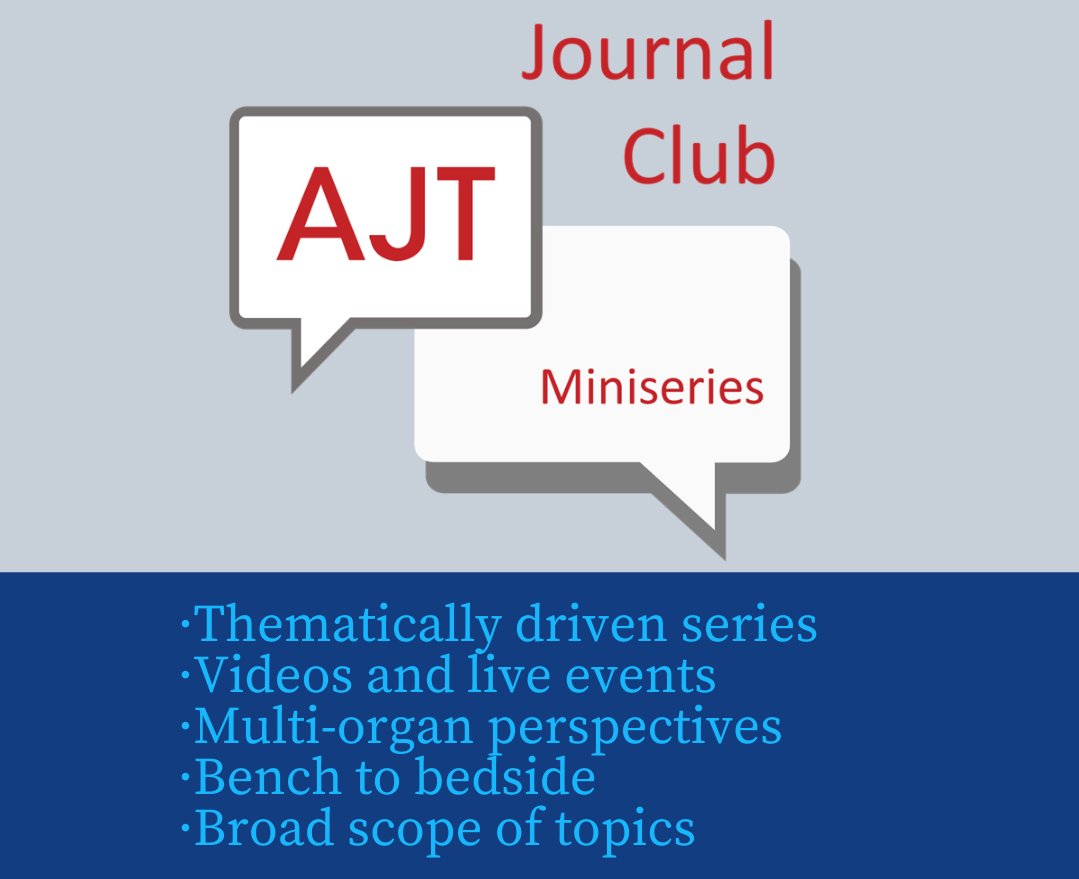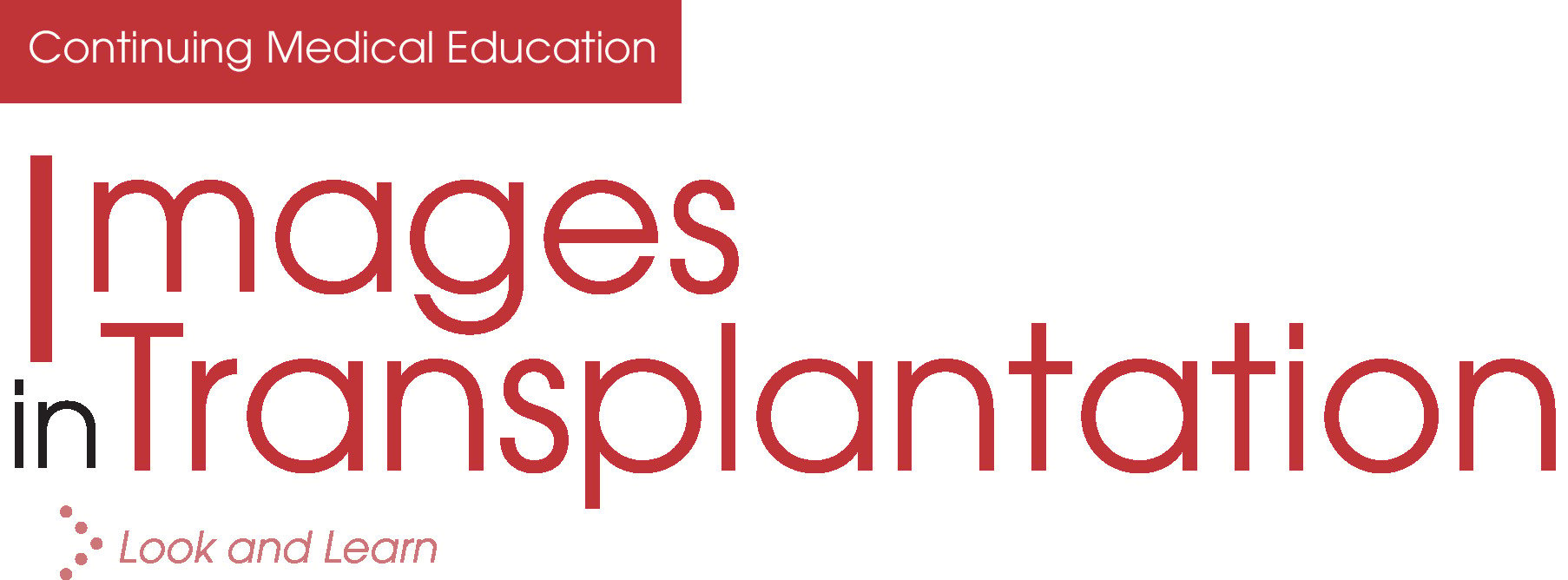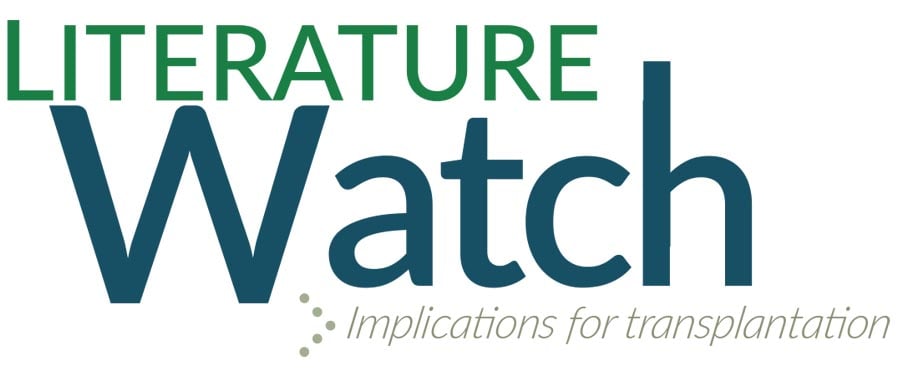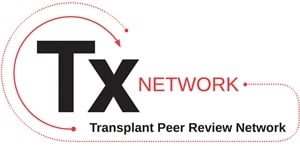Journal list menu
Export Citations
Download PDFs
Cover Image
American Journal of Transplantation: Volume 14, Number 11, November 2014
- First Published: 18 October 2014
On the cover this month: Substantial progress has been made in the last 5 years in bioengineering and regenerative medicine. This month, Taylor et al (page 2448) provide an update on the remarkable advances in cardiac construction, and the role this emerging option may play in the future of multimodal therapy for patients with heart failure. Also see our Images in Transplantation section on page 2664 for the opportunity to earn CME credit. Cover design by Ken North, North Design Group.
The AJT Report
The AJT Report
- Pages: 2437-2438
- First Published: 18 October 2014
In this edition of “The AJT Report,” we review a new international treaty that will enact legislation to consistently and harshly punish participants of organ trafficking. Also this month, we talk to David Klassen, the first-ever chief medical officer for UNOS, about his goals for his new role.
Literature Watch
Literature Watch Implications for transplantation
- Page: 2439
- First Published: 18 October 2014
New data on the ligand-dependent internalization of CTLA-4 offers fresh insight into its mechanism of action and suggests that this property could be exploited as a novel method of drug delivery.
Editorials
Innate Immune Cell Collaborations Instigate Transplant Tolerance
- Pages: 2441-2443
- First Published: 13 October 2014
This editorial provides commentary on Hongo et al's (page 2467) demonstration that transplant tolerance induction after recipient conditioning with total lymphoid irradiation, antithymocyte serum, and donor bone marrow transplantation requires arginase-1–expressing myeloid-derived suppressor cells that are generated in response to invariant natural killer T cell interleukin-4 production.
KDPI and Donor Selection
- Pages: 2444-2445
- First Published: 25 August 2014
The authors discuss the clinical utility of the Kidney Donor Profile Index and pretransplant kidney biopsy in selection of marginal kidney donors, and why neither should be used alone for making a decision on organ acceptance or rejection. See article by Gandolfini et al on page 2515.
Evaluating the Safety and Rationale for Cinacalcet Posttransplant Hyperparathyroidism and Hypercalcemia
- Pages: 2446-2447
- First Published: 15 September 2014
This commentary discusses the benefits and limitations of cinacalcet use for posttransplant hypercalcemia and secondary hyperparathyroidism, alternative management options, and gaps in our evidence base. See article by Evenepoel et al on page 2545.
Minireviews
Building New Hearts: A Review of Trends in Cardiac Tissue Engineering
- Pages: 2448-2459
- First Published: 07 October 2014
This review discusses some of the factors that should be considered in the development of tissue-engineered products, and it describes the methods currently being investigated to generate more effective heart valves, cardiac patches, and whole hearts.
CD28 Negative T Cells: Is Their Loss Our Gain?
- Pages: 2460-2466
- First Published: 16 October 2014
The authors provide an overview of the circumstances leading to loss of the critical T cell costimulatory molecule CD28, and they discuss the transplant-relevant consequences of this sign of progressive T cell maturation.
Original Articles
Basic Science
Requirement for Interactions of Natural Killer T Cells and Myeloid-Derived Suppressor Cells for Transplantation Tolerance
- Pages: 2467-2477
- First Published: 13 October 2014
Chimerism and tolerance after conditioning with total lymphoid irradiation and antithymocyte serum requires interaction between myeloid-derived suppressor cells and natural killer T cells. See editorial by Ochando and Turnquist on page 2441.
Establishment of Transplantation Tolerance via Minimal Conditioning in Aged Recipients
- Pages: 2478-2490
- First Published: 12 September 2014
The problems of age-related thymic atrophy and immunosenescence in transplantation tolerance are overcome in this study using a radiation-free, low-intensity conditioning regimen that may be applicable to a broad range of clinical settings.
Critical Role of NKT Cells in Posttransplant Alloantibody Production
- Pages: 2491-2499
- First Published: 12 September 2014
Using a murine transplant model, the authors report a novel type I natural killer T cell–mediated mechanism that enhances the magnitude of IgG1 alloantibody production posttransplant.
Mechanistic Analysis of Nonoxygenated Hypothermic Machine Perfusion's Protection on Warm Ischemic Kidney Uncovers Greater eNOS Phosphorylation and Vasodilation
- Pages: 2500-2514
- First Published: 10 October 2014
This study provides the first evidence that preservation of renal grafts with nonoxygenated hypothermic machine perfusion activates the nitric oxide signaling pathway at the end of preservation and increases the nitric oxide–dependent vasodilation capacity of the renal artery and cortical microcirculation after reoxygenation.
Clinical Science
The Kidney Donor Profile Index (KDPI) of Marginal Donors Allocated by Standardized Pretransplant Donor Biopsy Assessment: Distribution and Association With Graft Outcomes
- Pages: 2515-2525
- First Published: 25 August 2014
This study shows that the standardized assessment of formalin-fixed pretransplant biopsies helps recover donors with KDPI in the highest range that would be otherwise discarded, and by providing the expected graft outcomes based on KDPI and pretransplant biopsy, it guides the clinician facing the difficult decision whether to accept or reject these organs. See editorial by Gupta et al on page 2444.
The Role of Minority Geographic Distribution in Waiting Time for Deceased Donor Kidney Transplantation
- Pages: 2526-2534
- First Published: 25 August 2014
This study demonstrates that organ procurement organization of listing is one of the most important contributors to the longer wait times for deceased donor kidney transplant experienced by minorities in the United States.
Emotional Well-Being of Living Kidney Donors: Findings From the RELIVE Study
- Pages: 2535-2544
- First Published: 07 October 2014
Using donor records, validated depression surveys, and donation experience questions from 2455 living kidney donors, the investigators find that most donors report emotional well-being years after donation, but for those with subsequent depression symptoms, identified predictors provide an opportunity for intervention.
A Randomized Study Evaluating Cinacalcet to Treat Hypercalcemia in Renal Transplant Recipients With Persistent Hyperparathyroidism
- Pages: 2545-2555
- First Published: 15 September 2014
This randomized, placebo-controlled trial demonstrates that cinacalcet effectively and safely corrects hypercalcemia in adult patients with persistent hyperparathyroidism after successful kidney transplantation. See editorial by Coyne and Delos Santos on page 2446.
Early Corticosteroid Avoidance in Kidney Transplant Recipients Receiving ATG-F Induction: 5-Year Actual Results of a Prospective and Randomized Study
- Pages: 2556-2564
- First Published: 19 September 2014
This study identifies similar long-term graft and patient survival in recipients of primary kidney transplants independently if steroids are avoided from the day of surgery or withdrawn thereafter; however, the pattern and late impact of acute rejection, as well as the safety profile, differ between these two groups.
Molecular Landscape of T Cell–Mediated Rejection in Human Kidney Transplants: Prominence of CTLA4 and PD Ligands
- Pages: 2565-2576
- First Published: 12 September 2014
The molecules that distinguish T cell–mediated rejection of human kidney transplants from other diseases reflect the cognate effector T cell antigen-presenting cell synapse and include negative costimulatory molecules, and they are distinct from the nonspecific inflammatory response and the response to injury.
A Comprehensive Analysis of the Cellular and EBV-Specific MicroRNAome in Primary CNS PTLD Identifies Different Patterns Among EBV-Associated Tumors
- Pages: 2577-2587
- First Published: 04 August 2014
The microRNA expression profile of primary central nervous system posttransplant lymphoproliferative disorders that develop in solid organ transplant recipients significantly differs from its systemic counterparts, suggesting that both entities result from distinct pathogenic mechanisms.
Survival Benefit of Repeat Liver Transplantation in the United States: A Serial MELD Analysis by Hepatitis C Status and Donor Risk Index
- Pages: 2588-2594
- First Published: 19 September 2014
This study shows that compared to first liver transplant, repeat liver transplant requires a higher model for end-stage liver disease score threshold to achieve a survival benefit, resulting in a narrower therapeutic window for optimal utility of scarce liver grafts.
Islet Product Characteristics and Factors Related to Successful Human Islet Transplantation From the Collaborative Islet Transplant Registry (CITR) 1999–2010
- Pages: 2595-2606
- First Published: 02 October 2014
Product criteria from clinical grade allogeneic human islets exhibit consistently superior-quality characteristics and significantly increasing islet equivalent yield, paralleling improving success rates of islet transplantation for type I diabetes.
Brief Communications
Comprehensive Bio-Imaging Using Myocardial Perfusion Reserve Index During Cardiac Magnetic Resonance Imaging and High-Sensitive Troponin T for the Prediction of Outcomes in Heart Transplant Recipients
- Pages: 2607-2616
- First Published: 07 October 2014
The high-sensitive troponin T, an established marker of cardiovascular risk, and quantitative myocardial perfusion reserve during vasodilator cardiac magnetic resonance exhibit complementary value for the prediction of chronic allograft vasculopathy progression and clinical outcomes in cardiac transplant recipients.
Demethylation of the TSDR Is a Marker of Squamous Cell Carcinoma in Transplant Recipients
- Pages: 2617-2622
- First Published: 23 September 2014
This study demonstrates that the proportion of naturally occurring regulatory T cells, identified by a specific demethylated region in the forkhead box P3 locus, is associated with increased cutaneous squamous cell carcinoma in kidney transplant recipients and is a useful biomarker of cancer risk.
Recurrent 2,8-Dihydroxyadenine Nephropathy: A Rare but Preventable Cause of Renal Allograft Failure
- Pages: 2623-2632
- First Published: 10 October 2014
The authors report on nine patients with recurrent 2,8-dihydroxyadenine nephropathy following renal transplantation, pointing to adenine phosphoribosyltransferase deficiency as a rare but significant cause of renal allograft dysfunction.
Case Reports
Transmission of Methicillin-Resistant Staphylococcus aureus Infection Through Solid Organ Transplantation: Confirmation Via Whole Genome Sequencing
- Pages: 2633-2639
- First Published: 22 September 2014
This manuscript describes two cases of donor-derived methicillin-resistant Staphylococcus aureus (MRSA) bacteremia, confirmed through comparison of S. aureus whole genome sequence of DNA extracted from fixed donor tissue and recipients' isolates, that developed after transplantation of organs from a common donor who died from acute MRSA endocarditis. Also see case report by Altman et al on page 2640.
Transmission of Methicillin-Resistant Staphylococcus aureus via Deceased Donor Liver Transplantation Confirmed by Whole Genome Sequencing
- Pages: 2640-2644
- First Published: 22 September 2014
This report describes a successful outcome in a liver transplant recipient after deceased donor transmission of methicillin-resistant Staphylococcus aureus confirmed by whole genome sequencing. Also see case report by Wendt et al on page 2633.
Parvovirus Associated Fulminant Hepatic Failure and Aplastic Anemia Treated Successfully With Liver and Bone Marrow Transplantation. A Report of Two Cases
- Pages: 2645-2650
- First Published: 01 September 2014
The authors describe two cases of parvovirus B19–associated fulminant hepatic failure and aplastic anemia managed with sequential liver and bone marrow transplantation and excellent long-term outcome.
Graft-Versus-Host Disease After Simultaneous Pancreas–Kidney Transplantation: A Case Report and Review of the Literature
- Pages: 2651-2656
- First Published: 12 September 2014
The authors present a case of graft-versus-host disease after simultaneous pancreas–kidney transplantation, including its clinical manifestations, use of cytogenetic techniques for diagnosis and monitoring, and successful treatment with high-dose steroids, high tacrolimus levels, and extracorporeal photopheresis.
Conversion From Tacrolimus to Belatacept to Prevent the Progression of Chronic Kidney Disease in Pancreas Transplantation: Case Report of Two Patients
- Pages: 2657-2661
- First Published: 01 September 2014
The authors describe two cases of pancreas transplant recipients whose calcineurin inhibitor maintenance regimen was converted to belatacept to avoid chronic kidney disease progression, which allowed these patients to be maintained pancreas rejection–free on belatacept therapy, while maintaining excellent renal function.
Reports From the CDC: MMWR
Severe Respiratory Illness Associated with Enterovirus D68—Missouri and Illinois, 2014
- Pages: 2662-2663
- First Published: 18 October 2014
This report details an increase in cases of enterovirus D68, a cause of severe respiratory illness most commonly found in children, and one that should be considered as potentially problematic in donors or recipients.
Images in Transplantation
CME
A 60-Year-Old Man With Necrotic Skin Lesions After Heart Transplantation
- Pages: 2664-2666
- First Published: 18 October 2014
Letters to the Editor
HLA Epitopes and Tolerance Induction Protocols
- Page: 2667
- First Published: 10 September 2014
Less Sensitization But Not Necessarily More Tolerance With Better Matching
- Page: 2668
- First Published: 10 September 2014
Kidney Transplant Access in the Southeast: Middle View
- Pages: 2669-2670
- First Published: 12 September 2014
Long-Term Risks of Kidney Donation: Age Known
- Pages: 2671-2672
- First Published: 07 October 2014










.jpg)
